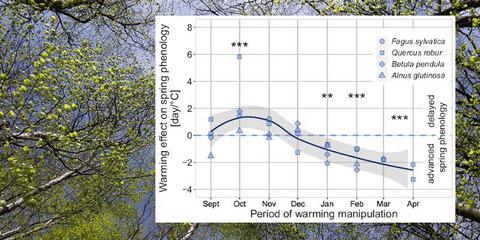当前位置:
X-MOL 学术
›
Glob. Change Biol.
›
论文详情
Our official English website, www.x-mol.net, welcomes your
feedback! (Note: you will need to create a separate account there.)
Late to bed, late to rise—Warmer autumn temperatures delay spring phenology by delaying dormancy
Global Change Biology ( IF 10.8 ) Pub Date : 2021-08-24 , DOI: 10.1111/gcb.15858 Ilka Beil 1 , Jürgen Kreyling 1 , Claudia Meyer 1 , Nele Lemcke 1 , Andrey V Malyshev 1
Global Change Biology ( IF 10.8 ) Pub Date : 2021-08-24 , DOI: 10.1111/gcb.15858 Ilka Beil 1 , Jürgen Kreyling 1 , Claudia Meyer 1 , Nele Lemcke 1 , Andrey V Malyshev 1
Affiliation

|
Spring phenology of temperate forest trees has advanced substantially over the last decades due to climate warming, but this advancement is slowing down despite continuous temperature rise. The decline in spring advancement is often attributed to winter warming, which could reduce chilling and thus delay dormancy release. However, mechanistic evidence of a phenological response to warmer winter temperatures is missing. We aimed to understand the contrasting effects of warming on plants leaf phenology and to disentangle temperature effects during different seasons. With a series of monthly experimental warming by ca. 2.4°C from late summer until spring, we quantified phenological responses of forest tree to warming for each month separately, using seedlings of four common European tree species. To reveal the underlying mechanism, we tracked the development of dormancy depth under ambient conditions as well as directly after each experimental warming. In addition, we quantified the temperature response of leaf senescence. As expected, warmer spring temperatures led to earlier leaf-out. The advancing effect of warming started already in January and increased towards the time of flushing, reaching 2.5 days/°C. Most interestingly, however, warming in October had the opposite effect and delayed spring phenology by 2.4 days/°C on average; despite six months between the warming and the flushing. The switch between the delaying and advancing effect occurred already in December. We conclude that not warmer winters but rather the shortening of winter, i.e., warming in autumn, is a major reason for the decline in spring phenology.
中文翻译:

晚睡,晚起——温暖的秋季气温通过延迟休眠来延迟春季物候
由于气候变暖,温带森林树木的春季物候在过去几十年里有了很大的进步,但尽管气温持续上升,但这种进步正在放缓。春季提前的下降通常归因于冬季变暖,这可能会减少寒冷,从而延迟休眠释放。然而,缺乏对温暖冬季温度的物候反应的机械证据。我们旨在了解变暖对植物叶片物候的对比影响,并解开不同季节的温度影响。随着一系列的每月实验变暖约。从夏末到春季 2.4°C,我们分别使用四种欧洲常见树种的幼苗量化了每个月林木对变暖的物候响应。为了揭示潜在的机制,我们跟踪了环境条件下以及每次实验升温后休眠深度的发展。此外,我们量化了叶片衰老的温度响应。正如预期的那样,较暖的春季气温导致了较早的落叶。变暖的推进效应已经在 1 月份开始,并在潮红时增加,达到 2.5 天/°C。然而,最有趣的是,10 月的变暖产生了相反的效果,春季物候平均延迟了 2.4 天/°C;尽管在变暖和潮红之间有六个月的时间。延迟效应和推进效应之间的转换已经发生在 12 月。我们得出结论,不是温暖的冬季而是冬季的缩短,即秋季变暖,是春季物候下降的主要原因。
更新日期:2021-10-15
中文翻译:

晚睡,晚起——温暖的秋季气温通过延迟休眠来延迟春季物候
由于气候变暖,温带森林树木的春季物候在过去几十年里有了很大的进步,但尽管气温持续上升,但这种进步正在放缓。春季提前的下降通常归因于冬季变暖,这可能会减少寒冷,从而延迟休眠释放。然而,缺乏对温暖冬季温度的物候反应的机械证据。我们旨在了解变暖对植物叶片物候的对比影响,并解开不同季节的温度影响。随着一系列的每月实验变暖约。从夏末到春季 2.4°C,我们分别使用四种欧洲常见树种的幼苗量化了每个月林木对变暖的物候响应。为了揭示潜在的机制,我们跟踪了环境条件下以及每次实验升温后休眠深度的发展。此外,我们量化了叶片衰老的温度响应。正如预期的那样,较暖的春季气温导致了较早的落叶。变暖的推进效应已经在 1 月份开始,并在潮红时增加,达到 2.5 天/°C。然而,最有趣的是,10 月的变暖产生了相反的效果,春季物候平均延迟了 2.4 天/°C;尽管在变暖和潮红之间有六个月的时间。延迟效应和推进效应之间的转换已经发生在 12 月。我们得出结论,不是温暖的冬季而是冬季的缩短,即秋季变暖,是春季物候下降的主要原因。











































 京公网安备 11010802027423号
京公网安备 11010802027423号